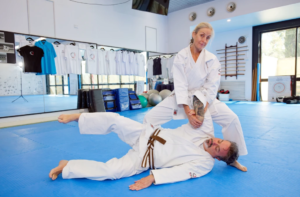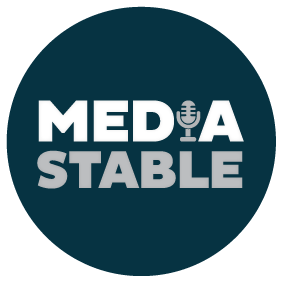Liz Kirk (PhD) – Financial Review
Health, Safety & Wellness Expert for Computer-Intensive Work | Researcher, Speaker & Trainer
Get fit for retirement by starting with these micro hacks.
It’s a Friday morning, and Liz Kirk, 61, is ready to throw down – in a safe and controlled environment, of course.
The workplace ergonomics consultant is at Jan de Jong Martial Arts in Perth, where she’s been doing jiu-jitsu since late 2022. She started when she realised that as she grew older, she wanted to be able to feel safe and confident that she could defend herself.
Kirk had just spent about 18 months looking after her frail mother, and hadn’t been able to leave the house for more than 15 minutes at a time. Her exercise regime fell by the wayside.
Research by fund manager Challenger finds that losing physical health is retirees’ biggest concern about getting older, and 70 per cent also think physical health is the biggest contributor to a happy retirement.
Age aside, few Australians are meeting recommended physical activity guidelines, according to the Australian Bureau of Statistics. That includes doing strength and toning activities twice a week and 150 minutes or more of exercise a week.
The percentage of people who do the recommended amount drops with age. While 31 per cent of those aged 18 to 24 meet the guidelines, by 45 to 54, only 18 per cent meet the benchmark, and by 55-64, the figure is 16 per cent.
Given retirement is often thought of as the time to spend running after grandkids, playing golf and travelling, the level of physical fitness has the power to entirely shape the experience.
How much exercise should I be doing?
According to the World Health Organisation, the recommended amount of exercise you should be doing a week doesn’t differ whether you’re 18 or 68.
The WHO suggests at least:
- 150–300 minutes of moderate intensity aerobic physical activity.
- Or, 75–150 minutes of vigorous physical activity.
- Strength training at least twice a week.
- Limit the amount of time being sedentary.
But, for those over 65, it suggests they also add in some training that emphasises functional balance and strength training to prevent falls.
She says even if you’ve been sedentary in a desk job for many years, there’s no time like the present to start. Just don’t go too hard, too fast.
“The most common mistake that we see – especially after the new year – is people taking an ‘all or nothing’ approach,” Ding says.
That means setting hard-to-achieve outcomes, triggering injuries.
The other mistake people often make is giving up too quickly. “One thing to understand is that we have to gradually build up our strength, endurance and cardiovascular capacity,” Ding says.
Big goals are good, but it’s important to set smaller goals too. And remember, when done well (that is, not overdoing it), exercising and eating healthily actually feel good. Ding’s advice is to try to enjoy the process.
“It’s really important that we tune in with our body, and see how we feel with the middle steps,” she says.
Body, balance, bones
In a typical working day, the average office worker will spend about eight or nine hours at work, and most of that when seated. Fitting an hour of exercise in doesn’t seem too difficult, but commutes, family responsibilities, social events and the need for downtime can make it tricky.
Anna-Louise Bouvier, the founder of physiotherapy company Physiocise and adjunct fellow at Macquarie University, says that when it comes to getting fit and healthy after years or perhaps decades of inactivity, it’s easy to get overwhelmed.
“The research is increasingly showing that a little, often is really effective. The more you focus on a few simple things, the more likely you are to start to make big changes,” she says.
“We know it all comes down to your body, your balance and your bones.”
Bouvier says the beauty of focusing on these three things is that it makes it easier to begin to change your habits.
Body hack
“Strength is a really big one,” Bouvier says.
Humans tend to lose between 3 per cent and 8 per cent of muscle mass every decade beyond the age of 30, but this accelerates after 60.
One easy way to begin to gain back some leg strength after decades at a desk is to do what she terms “the hover”.
“One of the simplest things is to practice squatting. When you go to get off your chair, you just lean forward, and you lift up, and you hover for 10 seconds.
“Doing that five, six or 10 times a day is a great way to start getting some strength.”
Maybe just tell your colleagues what you’re doing, first.
Balance hack
Most people don’t think about balance until they fall, Bouvier says.
A study in the British Journal of Sports Medicine last year looked at participants’ ability to stand on one leg for 10 seconds in mid-later life. It found that an inability to do it was linked to a near-doubling in the risk of death of any cause within the next 10 years.
But the fix is simple: next time you’re brushing your teeth, practice standing on one leg for at least 10 seconds, alternating legs, twice a day.
“We know that if you link new habits to existing habits it can be really powerful,” Bouvier says.
“So, boiling the kettle, brushing your teeth – if you can add your body and balance habits to that, you’ve got a good chance of the habit lasting.”
If you want to invest some time and effort, Dr Ding recommends adding multimodal exercises like yoga, tai chi or dance.
Bones hack
Bones weaken as we age, and the last thing you want, on your round-the-world retirement trip, is to break a leg.
“One of the things we know that is fantastic for bones is that they like load and stomping is a really good way to improve your bone health,” Bouvier says.
“Stomping up and down the hallway is great for stress relief and really good for your bones.”
This is important, as we tend to do a lot of sitting – either at the computer or at the TV. Walking isn’t enough to build bone strength, instead, you need to think about dynamic load.
Invest in good gear
These are three easy ways to begin to make improvements, but if you’re planning an active lifestyle, and if the first thing on your to-do list is to hike the dolomites, you’re going to need to work a bit harder.
“One of the biggest mistakes people make is thinking that walking around the local streets is going to get them ready for a hike,” says Bouvier, who is the national patron of Coastrek which supports the Heart Foundation.
“Sign up for a walk because it gives you a goal,” she says.
Event organisers usually supply a training regime to help you build up to the ultimate distance goal.
Another tip is to invest in good gear: don’t go out and try to get fit in your old pair of Dunlop Volleys.
If you’re starting a new exercise regime after taking a long period off, it’s also a good idea to chat to your doctor first, and be mindful of any existing conditions.
But generally speaking, Ding says, if you’re in your 60s, you should still be able to engage in every form of exercise, albeit with moderation when starting out.
“I’m talking about moderate level, brisk walking and vigorous exercise such as tennis and jogging,” she says.
Ding emphasises the importance of goals because they will keep you on track and help you enjoy the process. For example, signing up for a 10km run, or even a 5km, is a good way to put some structure and urgency around a training plan. Running clubs are booming across Australia and the popular parkrun franchise operates in 484 locations.
Next, add social connections, Ding says. “We’re going through a social connection crisis, and exercise is a really good way to connect with people as well,” she says. “During COVID, we saw such an increase in catching up and walking as the social activity, and that made people feel better. Whether it’s getting fitter, having a better mood, concentration, productivity or social time – we all need to find the thing that keeps us going.”
Finally, don’t give up. While the general rule of thumb is to aim for 150 minutes of exercise a week, Ding says a sharp reduction in the risk of premature mortality occurs when people simply shift from doing nothing to doing something.
It doesn’t have to be formal exercise, either. It could just be getting off one stop early and walking the rest of the way to work or home.
“The first 30 minutes that you invest in being active can give you the best bang for your buck,” she says.
Kirk does jiu-jitsu four times a week and works on tai chi once a week.
“Everything about it is about movement and … getting your strength and balance back, which is really important because as you age, you start to lose your balance,” she says.
“There’s a lot of mental benefit in that too because with any martial art, you have to be in the zone; otherwise you get hit. And because you’re in the zone, you have to break away from the stress of the day.”
Kirk wants to retire in five years, although she’s now got so much energy she’s not even sure she wants to retire any more.
“It’s all about the quality of life. Everything I do is about the care of other people. I want to be able to rush over to Anchorage to be with my niece because her kids are going crazy … and while I’m there, why don’t I take one of the National Geographic treks through the Andes?”
